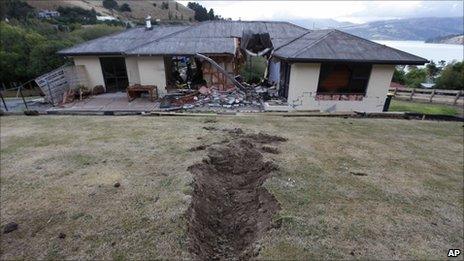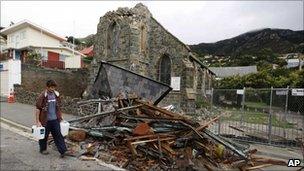New Zealand quake: The epicentre town
- Published

A huge boulder smashed through this bungalow in Lyttelton
The port of Lyttelton sits in a landscape of staggering beauty and from a distance looks deceptively tranquil.
But the town was the closest to the epicentre of Tuesday's quake.
Normally the port is reached from Christchurch by a tunnel that goes beneath the mountain range, but it has been closed to traffic all week because of damage from rockfalls.
Instead, we reached Lyttelton along the road that snakes through the valleys and follows the coastline of this beautiful natural harbour.
Just outside the port we saw one of the more startling sights of the Christchurch quake - a bungalow with a gaping hole through its middle that looked as if it had been hit by a missile rather than an earthquake.
At first glance, it was hard to make sense of what could have happened. But then, about 50m (165ft) further down the hill, we saw the massive boulder that had come hurtling down the escarpment and crashed through the core of the property.
It was the size of a small car, and had seemingly hopped over the road like a bouncing bomb. Most remarkable of all, perhaps, it had not killed anybody.
'Violent shaking'
As we drove into Lyttelton, we saw that parts of it were in ruins. Many of its Victorian heritage buildings are so badly damaged they will have to be demolished.
Its historic Time Ball building, among the last remaining in the world, was wrecked. So, too, was the Volcano Cafe in the main street, along with the Lava Bar next door.
As is the case everywhere in the quake zone, its churches have been badly damaged.
That said, given the scale of the quake, its proximity to the surface and the simple fact that Lyttelton spans the epicentre, its surprising how much of the port is still standing.
Still more amazing is that nobody was killed in the town itself, although two residents lost their lives walking in the hills. One man was discovered by his daughter, and had been felled by falling rocks.
The inside of one of the cafes on the main street run by Dave Radzner is strewn with broken coffee cups and plates, rubble from the fallen brickwork and splintered tables and chairs.
The quake hit at lunchtime, and the cafe was full. Half-eaten sandwiches remain on the tables.

Historic buildings have suffered severe damage in Lyttelton
Dave has vivid memories of the moment, at 1251 local time, when the quake hit.
"This was just a bang, and then, you know, carnage, just violent shaking," he said.
"There was a lot of screaming and 'get the hell out of here'. I was one of the first people out of the door, and I didn't stick around.
"My children are up at the school 100m away and I don't think I turned around. I just grabbed the kids and took them off home. As long as I have my wife and two children within arms reach of me that's all I need to operate."
Only one person was injured in the wrecked cafe, a waiter scalded by boiling water from a toppled urn.
'Like an avalanche'
Over the way, Alex Herbert had just finished repairing his family home from the damage caused by last September's earthquake. It had cost him $NZ140,000 ($105,000, £65,000), but the brick walls had fallen down again.
He was surfing at the time the quake hit. "All of a sudden I got this jerking feeling. I thought a shark was biting my board. I honestly thought I was being attacked by a shark," he said.
"I turned around and there was no shark there. But the water started doing these bizarre patterns. There was a change in air pressure. Up and down motions, and then I looked at Sumner and all the cliffs were falling down.
"It was just like an avalanche. Everywhere I looked, just rockfalls."
Lois Olgivie has run the Volcano Cafe and Lava Bar for 23 years, but fears that she will not be able to rebuild because no insurance company will offer cover.
"It means a lot. We've had a fantastic time. It's been a very community thing. A lot of people come in here for a meal and drink. It's going to be sad to see that go," she said.
"That's what we're looking at. I can't see insurers are going to insure brick or stone buildings."
Lyttelton's war memorial was also badly damaged. But the Anzac spirit it represents is about resilience and battling against the odds - and that is still intact.
- Published24 February 2011
- Published23 February 2011
- Published23 February 2011